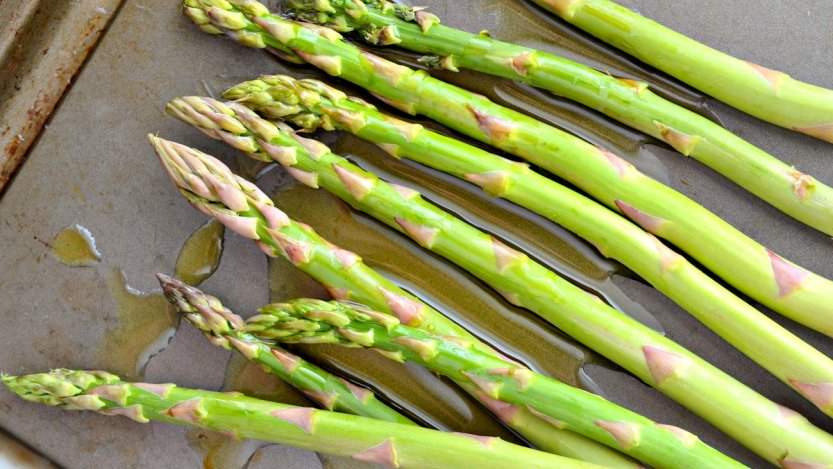Sure, we all know what people say: asparagus makes your trips to the loo, well, smell a little funky. But if that’s all that comes to mind when you think about the beautiful, delicate green spears of goodness, then you’re missing out.
Asparagus has a long history, dating back as far as 3000 B.C. when the Romans and Greeks cultivated it for medicinal use and offered it up to their gods. The cultivation of asparagus had spread through much of Europe by the end of the sixteenth century, and the Americas by the mid-nineteenth century.
A perennial member of the lily family, the asparagus’ root (or crown) is planted in an eight-inch deep trench, which is then filled with soil to level the earth. The asparagus’ very short window of awesome is intense, demanding, and exhausting. It isn’t harvested until the third spring, when the spears have reached approximately the full diameter of a pencil. Farmers begin to pick the tender spears some time in May (the harvest begins a little earlier in warmer areas of Canada, like the Okanagan and Ontario) and the harvest only lasts only approximately six weeks (in Alberta). Regardless of when farmers begin to hand-pick their crop, harvesting must wrap up by the end of June to allow the plant to grow into a fern, so the crowns can store nutrients for winter.
Not only is asparagus delicious (and nutritious), but its hyper-seasonality makes it even more exciting when it finally hits the shelves. What the hell is “hyper-seasonal”, you ask? It simply refers to an item that it is only available for a very short period of time; a season within a season, really. Asparagus is out of season long before summer is over. Perhaps that is why the delicious green bundles are so coveted and fly off local farmers’ market tables.
If you’re in the market for incredible food, it makes sense that you would seek out the freshest ingredients, and that can undoubtedly be found in your own backyard. There are a number of local asparagus producers across Canada that can be trusted to produce sweet, fresh asparagus, unlike any fibrous, woody imports you’ll find in December. So, put that Peruvian/Mexican/Californian bundle back on the shelf and hit a farmers’ market to get your hot little hands on a squeaky little bundle of asparagus.
Okanagan Asparagus Farms
Okanagan Asparagus Farms is a 152-acre farm located in Armstrong, B.C. that has been producing asparagus since 1997. As part of its belief in eating as close to home as possible, it offers farm gate sales of its asparagus from late April until mid June.
Just outside Innisfail, Alberta lies Edgar Farms, a 320-acre, sixth-generation family farm that has the largest asparagus operation in Alberta. Its unique central Alberta location with hot days and cool nights lends itself very well to growing some of the sweetest, most tender and flavourful asparagus you will ever taste. It offers farm gate sales and its produce can be found in many farmers’ markets as part of the Innisfail Growers Cooperative, like the Calgary Farmers’ Market. It also offers a two-day open house Asparagus Festival that is a great way to learn more about the farm, and is a great deal of fun for the whole family.
Spearit Farms
Spearit Farms in Norfolk County is Ontario’s foremost producer of asparagus. Ray and Brenda Lammens have 50 acres in asparagus alone. While they do have a small offering of asparagus through farm gate sales at their farm in Langton, Ontario, the bulk of their business is in direct sales to the food industry in Toronto, primarily high-end restaurants.
Vermeulen Farms
Vermeulen Farms is a thriving, three generation, 450-acre fruit and vegetable farm in Canning, Nova Scotia, that has been providing Atlantic Canadians with top quality produce since 1986. It boasts efficient and sustainable labour, equipment, and land that altogether grows nearly two dozen different offerings. And the best part is, they can be found not only at local Atlantic farmers’ markets, but at a wide variety of grocery stores. It couldn’t have made it any easier to enjoy fresh, local, sustainable asparagus than picking up a bundle at the neighbourhood co-op.
Choosing Asparagus
Bigger isn’t always better. Thick asparagus is just more mature than its thin counterpart. Instead, look for firm stems and tightly closed purple-tipped spears.
Storing asparagus
Stand the bundle of asparagus in an inch of water in a jar in the fridge and cover loosely with a plastic bag. Asparagus will keep in the fridge for at least one week.













